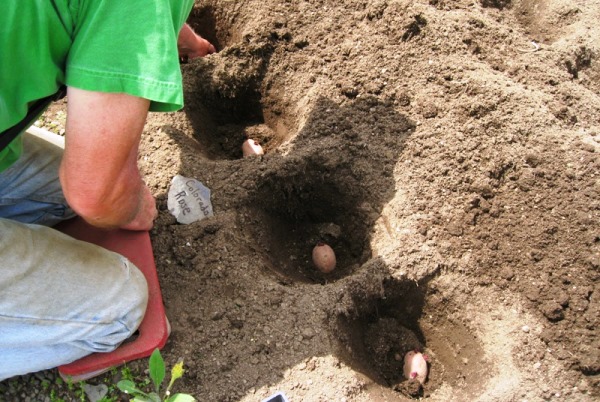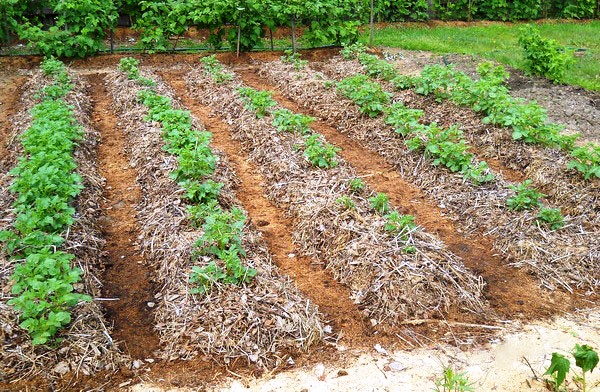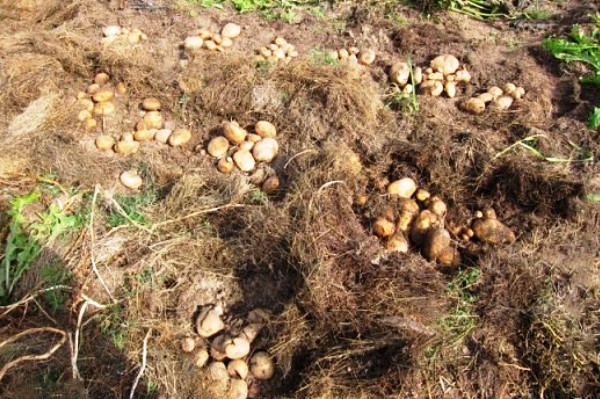Correct planting depth of potatoes
The yield of any vegetable crop depends on many factors: temperature regime, seed quality, timeliness and efficiency of processing, adherence to the rules of planting or sowing. This also applies to growing potatoes. First you need to choose the right variety, germinate the seeds and prepare for planting in the soil. If you are a novice gardener, you should learn some rules, since even the depth of planting of potatoes plays an important role in the harvest.
Content
What depth to plant
The planting depth of potatoes is classified into shallow, medium, deep. With shallow planting, seeds are buried to a depth of 5-6 cm. Usually this method is used on loamy soils. Loamy sands and peats allow deeper planting - up to 10 cm. Potatoes are also planted to a depth of more than 10 cm, this type is accordingly called deep. It is important that the planting depth is the same throughout the entire area. To achieve this goal, they use specialized equipment.
Planting depth depends not only on the type of soil, but also on the size of the seed. If the tubers are small, then they can be embedded shallowly. For a seed weighing 50-80 g, the best embedding depth is 8-9 cm, or when planting in ridges - 10-12 cm.For finer material with a flat surface, embedding is carried out to a depth of 6-7 cm, and in ridges - 8-9 cm.
As you know, the Dutch are famous for their unique methods of growing vegetables and various crops. In Holland, potatoes are planted so that the top of the tuber is at ground level, over which a ridge is formed. If you plant even smaller, potatoes from the new crop can be greened.
Formed plants are best placed in the ground when planted deeply. In this case, there is no need to huddle the bushes. But on the other hand, it will be difficult to harvest. Therefore, this type is recommended for use on sandy loam soil, in arid areas.
There is also an interesting technique in which the seed is laid out on top of slightly loosened soil and covered with 10-12 cm of mulch. Mulch is peat, compost, a mixture of humus with straw or rotted sawdust with sand, to which mineral fertilizers rich in trace elements necessary for potato growth are added. It is recommended to use this method in heavy soil, such as clay. To prevent gardening of tubers, you need to add more mulch when the plants reach a height of 20-25 cm.
The main advantage of this method is the free development of the root system. Mulch perfectly retains moisture and air, contains nutrients. In hot weather, the plants will be cool under the mulch; when the air temperature drops, on the contrary, it will be warm. This will ensure drainage around the roots and suppress weed growth. Loosening of the soil will be provided by earthworms, which, by cultivating the soil, will process organic elements into humus. To combat the Colorado potato beetle, wireworm or other parasites and diseases, green needles are added to the mulch. Thus, using this method, you can get 50% more yield.
The tubers are almost on the surface, so it is quite easy to harvest the potatoes. No effort is needed, as the tubers usually rise with the tops. There is no need to prepare a new mulch every year. The combs of organic matter hibernate in the garden, they are pushed apart, the seed is laid and filled back.It is permissible not to make continuous rollers, but to cover the tubers with separate mounds. In this case, it is recommended to plant plants at a distance of up to 40 cm for better development of the tops.
The relationship between depth and landing dates
Potato yield may decline if planted too early or too late. The timing depends on the depth of warming up the soil. The optimal conditions are heating up to 6-8 degrees to a depth of 10 cm. In this case, the tubers will quickly germinate and new shoots will appear. Scientists have proven that there is no strict relationship between the temperature of soil warming and the timing of planting potatoes. But it is still better to land early. Potatoes can maintain their vital activity at a temperature of 2-3 degrees. When planted in soil heated to 6-8 degrees, plants may develop slightly worse. Thus, the sooner the better.
Seeds are planted shallow, as the topsoil warms up better. Usually, planting begins in early April to late May. In warmer regions in late March-early April. Statistics show that if you are 10 days late, the yield will decrease by 10-20%, and if by 15-20 days, then by as much as 20-30%. This will reduce the starch content of potatoes by 1-2%.
In a rainy and cold spring, it is better to reduce the planting of potatoes by 1-2 cm, and in warm weather, on the contrary, increase by the same amount. It should be remembered that the depth should not be more than 12 and less than 5 cm. If this condition is not adhered to, germination will significantly decrease and, accordingly, yield too.
Recently, a new way of growing potatoes has appeared - before winter. The advantages of this method are early shoots and prevention of diseases, since the harvest will ripen already before the start of the heat and the spread of late blight. But in this case, you must carefully follow all the recommendations. If you leave potatoes to winter in the ground up to 12 cm, it will freeze and rot. The tubers will be too pressed down by a layer of earth, and the sprouts will come out for a long time, provided that the depth is increased to 20-30 cm.Thus, the optimal depth for planting potatoes before winter is 12-20 cm.
If you want to get a great harvest, follow the tips for planting potatoes, then you will succeed.
Video "Preparing the soil and planting potatoes"
The video gives advice on planting potatoes: how to plant, at what depth, which method is better.





